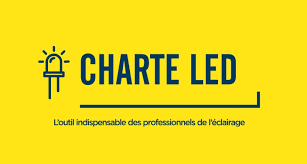Charter for indoor and outdoor LED lighting
Syndicat de l’éclairage, December 2018
With the LED Charter, which presents twenty criteria for objectively assessing the quality of LED luminaires for indoor and outdoor lighting, the Syndicat de l’éclairage has provided the market with a decision-making tool for the reasoned choice of lighting solutions.
To download : syndeclairage-charte-led-2021-09-web.pdf (1.4 MiB)

As the driving force behind the recent publication of the PSR Luminaires - which makes it possible to determine the environmental impact and analyse the life cycle of a luminaire as part of the PEP Ecopassport programme - the Syndicat de l’éclairage is now distributing a new reference document, useful to all players in the sector: the « LED Charter for indoor and outdoor lighting luminaires ». In support of this LED Charter, the union’s member manufacturers are proposing a list of precise and objective quality criteria, based on the safety and environmental performance standards of the International Electrotechnical Commission (IEC) and the European Committee for Electrotechnical Standardisation (CENELEC), to which the regulations refer. They are committed to providing reliable and accurate information according to these standards.
A collective voluntary commitment
Indeed, many market players are still in a fog, lost in a mix of vague, outdated, erroneous or biased statements and news. The LED Charter presents updated definitions of the main criteria to be considered: initial outgoing luminous flux, luminous efficacy, useful life, colour temperature, CRI, photobiological risk, maintenance of flux over time, etc.".
These criteria are recognised by European manufacturers, including those of the Syndicat de l’éclairage, which represents around two-thirds of the professional lighting market.
In 2014, the first LED Charter presented the commitment to provide 7 important criteria for choosing an LED luminaire. Four years later, as products and associated standards have progressed, a 20-criteria LED Charter has emerged. Each criterion is presented and explained simply. Each criterion is presented and explained in simple terms, with a reference to the precise paragraph of the standard that defines it.
This is not a marketing claim, but a measurable and verifiable element, via a published and recognised standard.
A Charter for trust
The LED Charter responds perfectly to the market’s need for confidence in products. Voluntary quality marks, such as NF, could have this role, but have never really penetrated the professional lighting market: end customers do not demand them, the organisations that sell them do not promote them, and manufacturers derive little benefit from them, but pay an annual usage fee. The « NF Luminaires » mark has disappeared, and the Certiled attempt has met with little success.
In fact, only the European ENEC and ENEC+ marks, created by the European organisation of lighting industry groups, seem to have found their place, with more than ten thousand certified products (luminaires and control gear/drivers). However, due to the cost of the right of use, the size of the catalogues and the rapid turnover of products, these brands tend to distinguish the best-selling product ranges.
Committed to the LED Charter, it is by claiming responsibility and reliability for their products and the performances they display that the manufacturers of the Lighting Union intend to establish a real climate of trust with the industry.
A tool for evaluating « equivalents
The 20 criteria of the LED Charter make it possible to identify a responsible, safe and sustainable product, but also to provide an objective prescription tool for all professionals in the sector, a neutral evaluation tool for alleged equivalents in performance.
Providing knowledge and confidence to all the players in the sector, offering users a reference system with which they can independently define the requirements specific to their activities, giving rise to better drafted specifications and better controlled lighting projects, should ultimately improve the quality of lighting installations in our country.
This charter is a single reference for all. As was the case a few years ago with the « Agreement on compliance with lighting standards », when it was only a matter of complying with safety requirements, the union is faithful to its policy of partnership: it is now planning to get the organisations representing the prescription, distribution and installation of lighting solutions to join this charter. The first contacts are promising!